Back to all Articles
Google AI Overview: Key Statistics & Facts You Need To Know

If you’ve noticed a new blue-green panel labeled Google AI Overview taking over the top of search results and you're wondering how it might affect your traffic and SEO strategy - here are some crucial insights you need to know.
In the next five minutes you will learn:
Let’s start with how dominant that panel has become.
In the next five minutes you will learn:
- Hard numbers on how often AI Overviews appear and how much space they hog.
- Proof of who loses clicks - and who unexpectedly gains them.
- Quick actions you can run today to stay visible.
Let’s start with how dominant that panel has become.
What is Google AI Overview?
Google AI Overview is a new feature that uses generative AI to create quick, summarized answers at the very top of search results. It pulls information from multiple websites to form a single response - so users often get what they need without ever scrolling down or clicking through to a site.
The catch? It’s fast and convenient for users - but it could be a major disruption for your SEO strategy.
The catch? It’s fast and convenient for users - but it could be a major disruption for your SEO strategy.
AI Overview by the numbers (+ strategies to stay visible)
Let’s look at the numbers to understand how often AI Overviews show up - and how much they’re changing the search landscape.
1. Visibility & real-estate
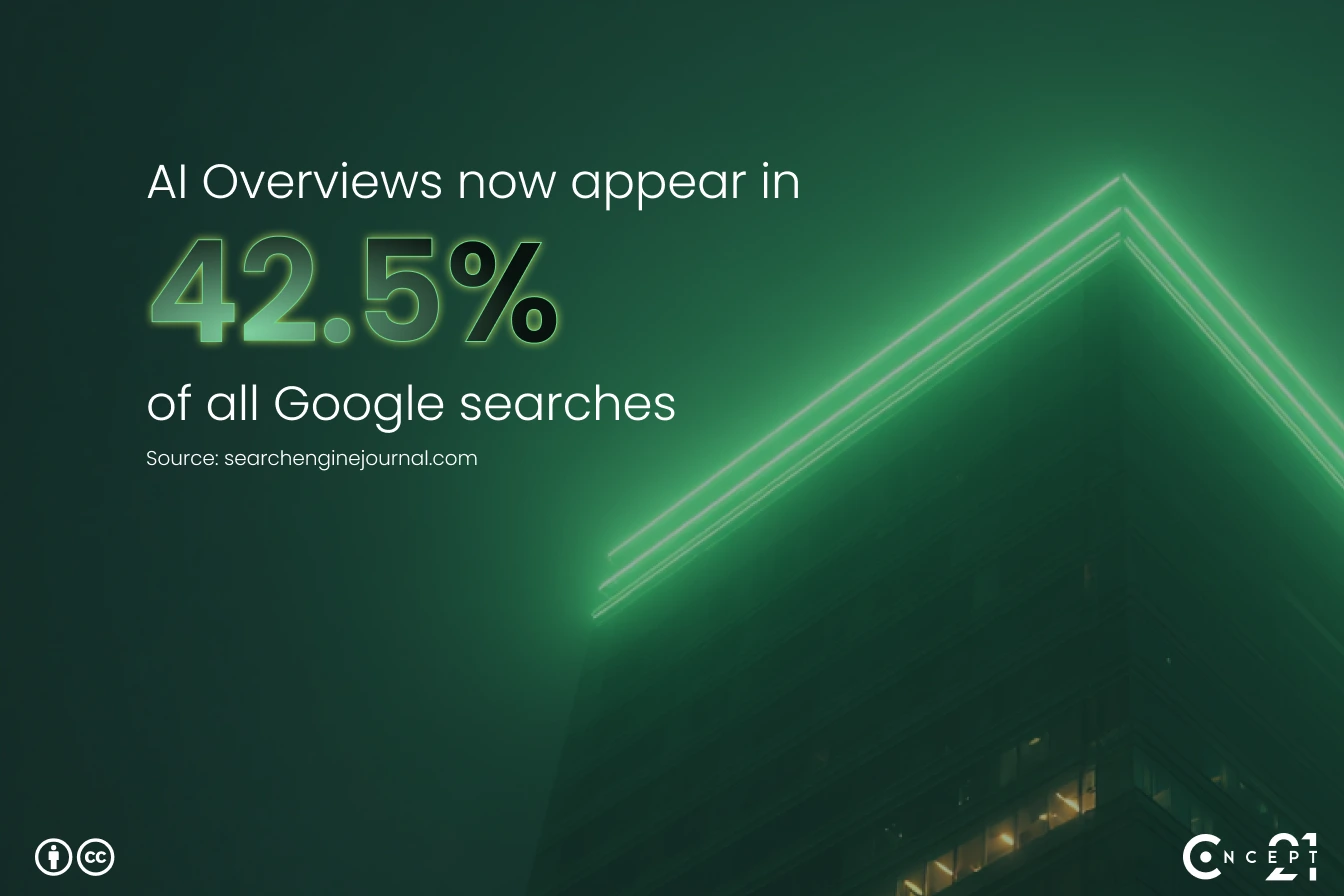
- AI Overviews now appear in 42.5% of all Google searches.
- On mobile, the box can fill up to 48% of the display - and when a featured snippet shows beside it, AI Overview + snippet together hog 75.7% of mobile and 67.1% of desktop real estate.
- On the desktop, clicking “Show more” in the panel shoves the page ~220 pixels down - pushing organic links even farther out of sight.
- A full 60% of searches end without any click because the AI Overview already answered the question.
- The “People Also Ask” box shows up in 80.92% of AI Overview queries.
- Mobile accounts for the vast majority of AIO traffic - 81% mobile vs. 19% desktop.
- The average AI Overview response is 4,342 characters long, up from a previous average of 3,485.
- AI Overviews appear alongside featured snippets 45.39% of the time, further crowding the SERP.
- 95% of keywords with AI Overviews have no ads or very low CPC, indicating a tilt toward informational queries.
- As much as 43.42% of AI Overview responses include links to regular organic search results from Google!
Google’s AI Overview is no longer just an experiment - it’s rapidly becoming the new default experience for a large portion of searchers. The sheer size and frequency of these panels mean that less screen space is available for traditional organic listings, especially on mobile.
High-ranking pages no longer guarantee high click-through rates. Even if your content is excellent and ranks well, users may never reach it because the AI Overview provides a summarized answer at the very top. In many cases, zero-click searches are becoming the norm, especially for informational queries.
This shift calls for a major rethink of SEO strategies - focusing not just on ranking, but on earning visibility within the AI Overview or targeting the kinds of queries it doesn’t yet dominate.
💡 Growth Tip:
Become the definitive source for intent-driven queries by deeply optimizing your content for entity relevance and semantic context.
Instead of just targeting keywords, build comprehensive content clusters around core topics that Google’s AI can easily interpret as authoritative and trustworthy. Use structured data (schema) to explicitly define entities, relationships, and key facts—helping Google’s algorithms confidently extract and cite your content in AI Overviews.
Become the definitive source for intent-driven queries by deeply optimizing your content for entity relevance and semantic context.
Instead of just targeting keywords, build comprehensive content clusters around core topics that Google’s AI can easily interpret as authoritative and trustworthy. Use structured data (schema) to explicitly define entities, relationships, and key facts—helping Google’s algorithms confidently extract and cite your content in AI Overviews.
2. Click-through-rate impact
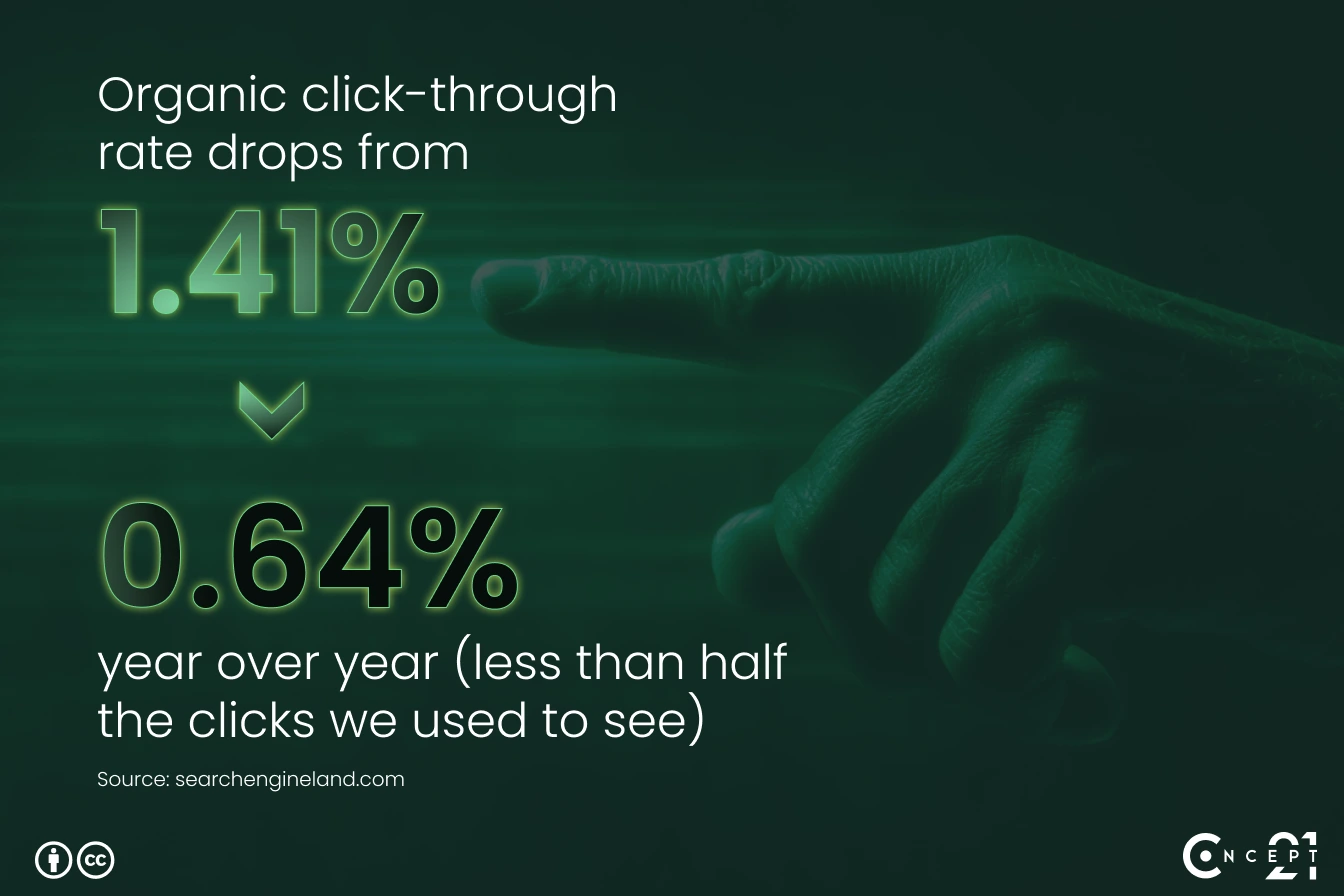
- Organic click-through rate drops from 1.41% to just 0.64% year over year—less than half the clicks we used to see.
- When the panel is absent, CTR actually rises. Outbound click rates jump to 28% on desktop and 38% on mobile.
- On desktop, CTR can plummet by two-thirds the moment an AI Overview shows up.
- 88% of users expand truncated AI Overviews by clicking “Show more”. Despite this, 7 in 10 users stop reading after just the first third of the Overview.
- Scroll depth varies by device. 54% of mobile users keep scrolling through the AIO, compared to just 29% on desktop.
- Interestingly, in 38% of sessions, users still seek reassurance by clicking a second organic link - often to confirm the AI summary.
What does it mean?
Count on less ‘passive’ traffic from your old top spots. Make your answers short, clear, and trustworthy so Google feels safe quoting you.
This shift favors precision, clarity, and trust. If your content feels quotable, Google is more likely to put it front and center - even if you're not at the top of the traditional rankings.
💡 Growth Tip:
Optimize your content specifically for “citation readiness” by creating authoritative, snippet-friendly answers that Google can confidently extract and quote in AI Overviews.
Use a direct, user-focused question or a clear subheading that matches common search queries.(example: “What is keyword difficulty in SEO?” ). Provide a straightforward definition or explanation immediately below the heading. Use simple language, avoid jargon, and keep sentences short. Include key facts or stats to add credibility. Don't forget to implement FAQPage, HowTo, or QAPage schema depending on content type.
Optimize your content specifically for “citation readiness” by creating authoritative, snippet-friendly answers that Google can confidently extract and quote in AI Overviews.
Use a direct, user-focused question or a clear subheading that matches common search queries.(example: “What is keyword difficulty in SEO?” ). Provide a straightforward definition or explanation immediately below the heading. Use simple language, avoid jargon, and keep sentences short. Include key facts or stats to add credibility. Don't forget to implement FAQPage, HowTo, or QAPage schema depending on content type.
3. Query & keyword triggers
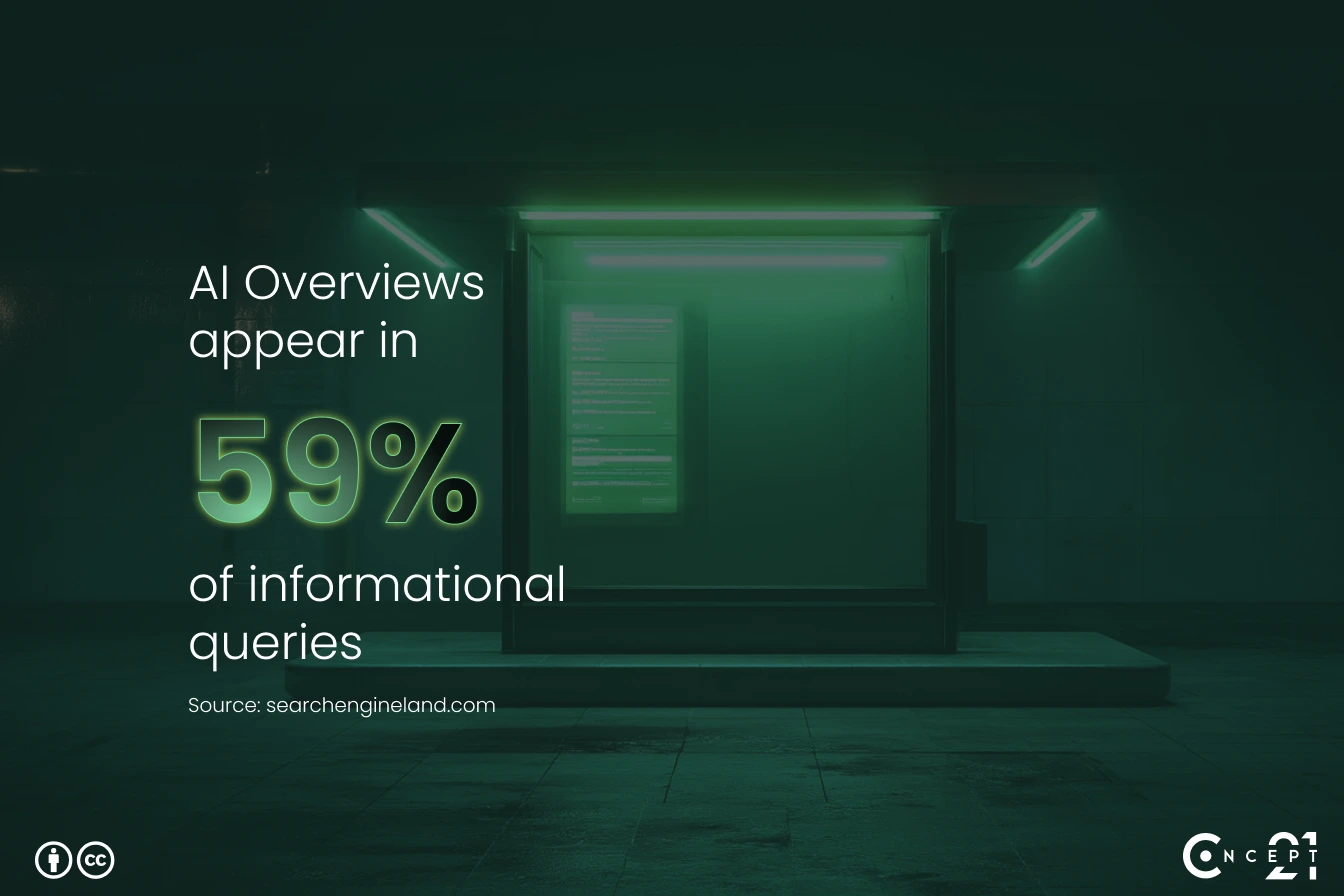
- Informational queries are the biggest trigger. AI Overviews appear in 59% of these searches, compared to just 19% of commercial (buyer-intent) queries.
- Give Google a 5-word long-tail keyword and you hit the panel 73.6% of the time.
- Low-volume terms (< 1k monthly searches) trigger AI Overview 55% of the time.
- 95% of keywords with an overview have a cost-per-click under $0.50 - there aren’t many ads fighting for space.
- Telecom leads at 56% of its keywords, while Beauty & Cosmetics see Google AI Overviews only 14% of the time.
- Non-branded queries (generic searches without a brand name) trigger AIOs 33.3% of the time, compared to just 19.6% for branded searches.
What does it mean?
Google’s AI Overview is heavily skewed toward informational, long-tail, and low-CPC searches - especially in industries where clear, factual answers matter more than brand or product comparison.
If you’re targeting top-of-funnel users with how-to guides, explainer content, or niche educational topics, you’re much more likely to run into the AI panel - and you’ll need to optimize for visibility inside it.
💡 Growth Tip:
- Export your keyword list from Search Console or your favorite tool.
- Keep any term with 5+ words or < 1 k searches a month.
- Sort by CPC ≤ $0.50.
- Flag the survivors - that’s where an AI Overview is most likely to steal the top slot.
- Rewrite or create content that answers the query in one tight paragraph, cites a source, and uses clear headings.
- Do that, and you have a high chance of showing up in Google AI Overview.
4. Citation & source dynamics
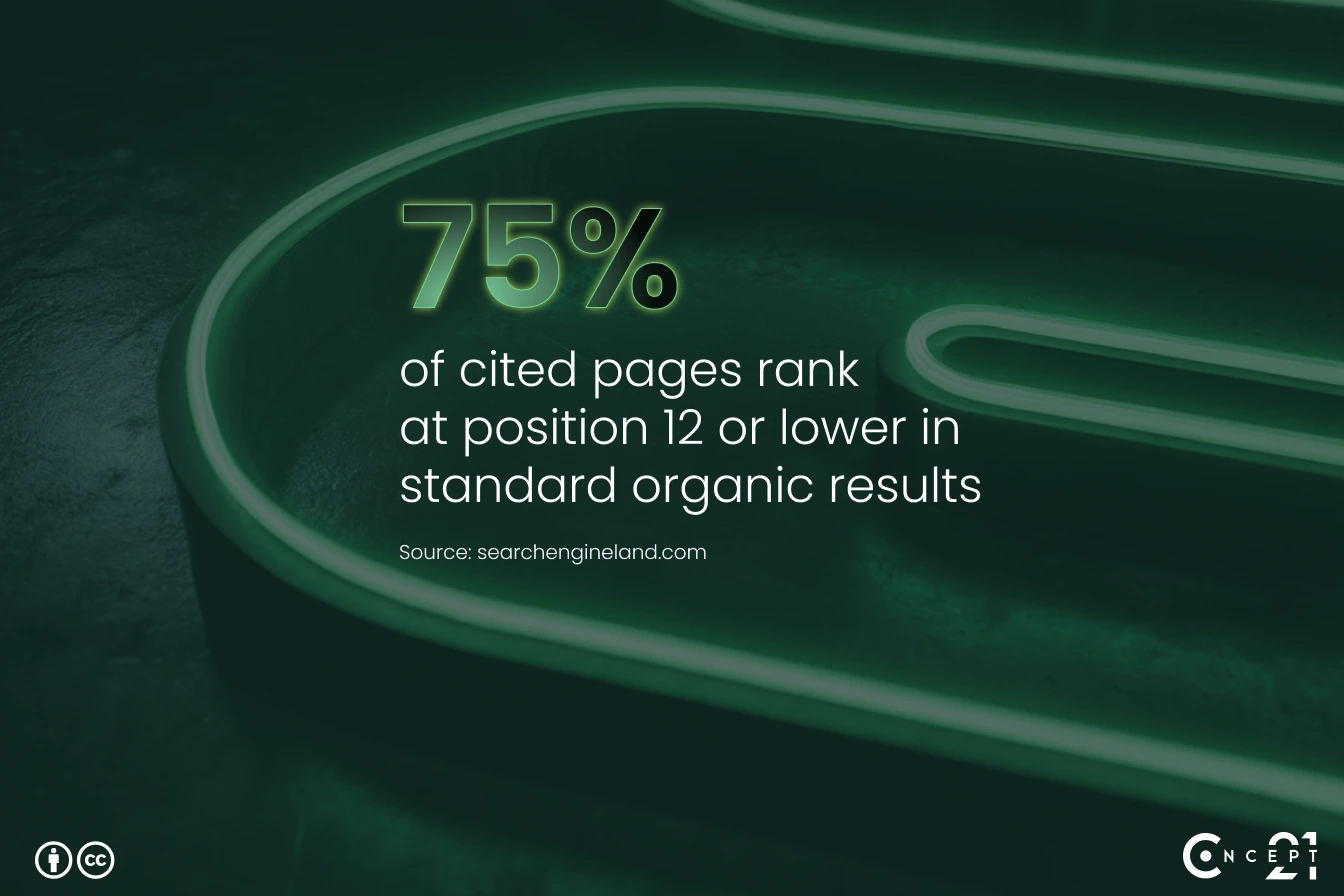
- AI Overviews cite about 13 sources on average. Most responses fall in the 6-to-14-link range.
- Where do those links rank? 52% sit in Google’s top-10 results - but nearly half come from beyond page 1.
- In fact, 75% of cited pages rank at position 12 or lower in standard organic results.
- Reassurance-seeking behavior exists. Roughly 90% users open a second link to verify the summary.
- There’s a 60%+ chance you’ll show up in AIO if you already own a featured snippet.
What does it mean?
A clear, trustworthy line anywhere on page one—or even page two—can leapfrog into the Overview and steal the click. Tighten your definitions, add sources, use schema and build credibility with expert reviews, .gov/.edu backlinks, and trusted mentions to improve your authority—even if you're not in the top organic slot.
💡Growth Tip:
When aiming for AIO citations, don’t judge success by referral traffic alone. Instead, track:
When aiming for AIO citations, don’t judge success by referral traffic alone. Instead, track:
- Impressions — how often your content appears within an AIO panel.
- Share of Voice — the frequency your brand is featured compared to competitors.
- Citation Rank — the prominence of your quote within the panel.
- Direct Traffic — visitors coming straight to your site.
- Branded Queries — searches that include your brand name.
5. Industry surges
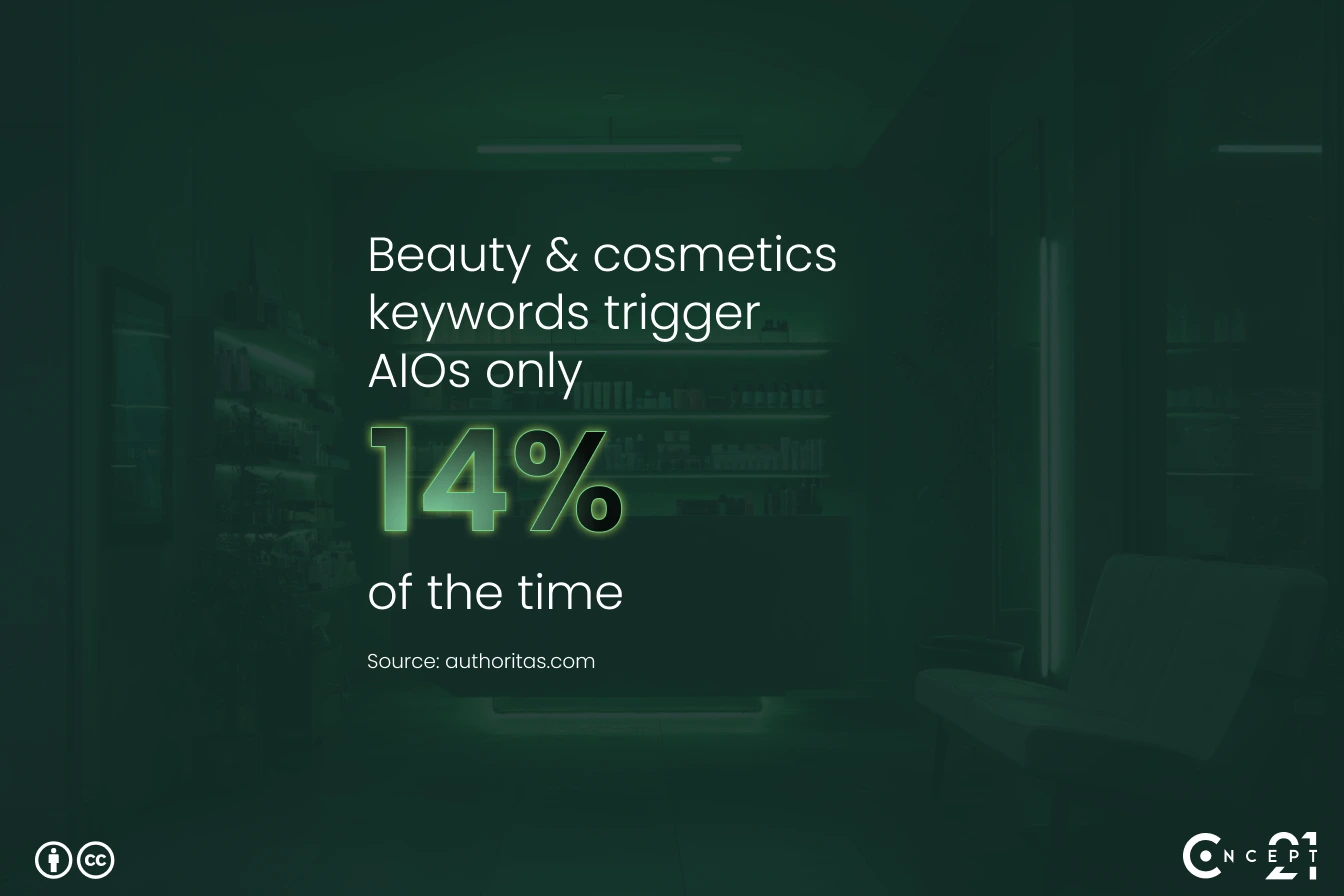
Most responses fall in the 6-to-14-link range.
Industry
Spike in AIO appearances
Entertainment
+ 528%
Restaurants
+ 387%
Travel
+ 381%
Combine this with earlier data, and a clear hierarchy emerges:
In health and finance, the impact on traffic tends to be less severe—sites in these sectors often experience smaller traffic drops because of lower people trust with AIO answers for these industries.
What does it mean?
If you’re in entertainment, food, travel, or telecom, assume the AI Overview panel is already siphoning off a significant share of clicks. Leverage local SEO and hyper-specific content (especially for restaurants and travel) can help you capture intent-driven searches outside the AIO scope.
For publishers in slower-moving niches, there’s still time to prepare—but the window is closing fast. Start adapting now to avoid getting left behind.
- Telecom keywords trigger AI Overviews 56% of the time
- Business Services see the panel on 41% of keywords
- Beauty & Cosmetics keywords trigger AIOs only 14% of the time
In health and finance, the impact on traffic tends to be less severe—sites in these sectors often experience smaller traffic drops because of lower people trust with AIO answers for these industries.
What does it mean?
If you’re in entertainment, food, travel, or telecom, assume the AI Overview panel is already siphoning off a significant share of clicks. Leverage local SEO and hyper-specific content (especially for restaurants and travel) can help you capture intent-driven searches outside the AIO scope.
For publishers in slower-moving niches, there’s still time to prepare—but the window is closing fast. Start adapting now to avoid getting left behind.
💡Growth Tip:
- Pull your top pages in any “spiking” niche.
- Check if they already appear (or could appear) in the panel—look for concise answers, bullet lists, stats.
- Add tightly sourced sentences and clear headings.
- Monitor weekly; these surges move fast.
- Stay ahead of the curve, and the AI Overview becomes a traffic faucet instead of a drain.
6. Keyword difficulty & hidden opportunities
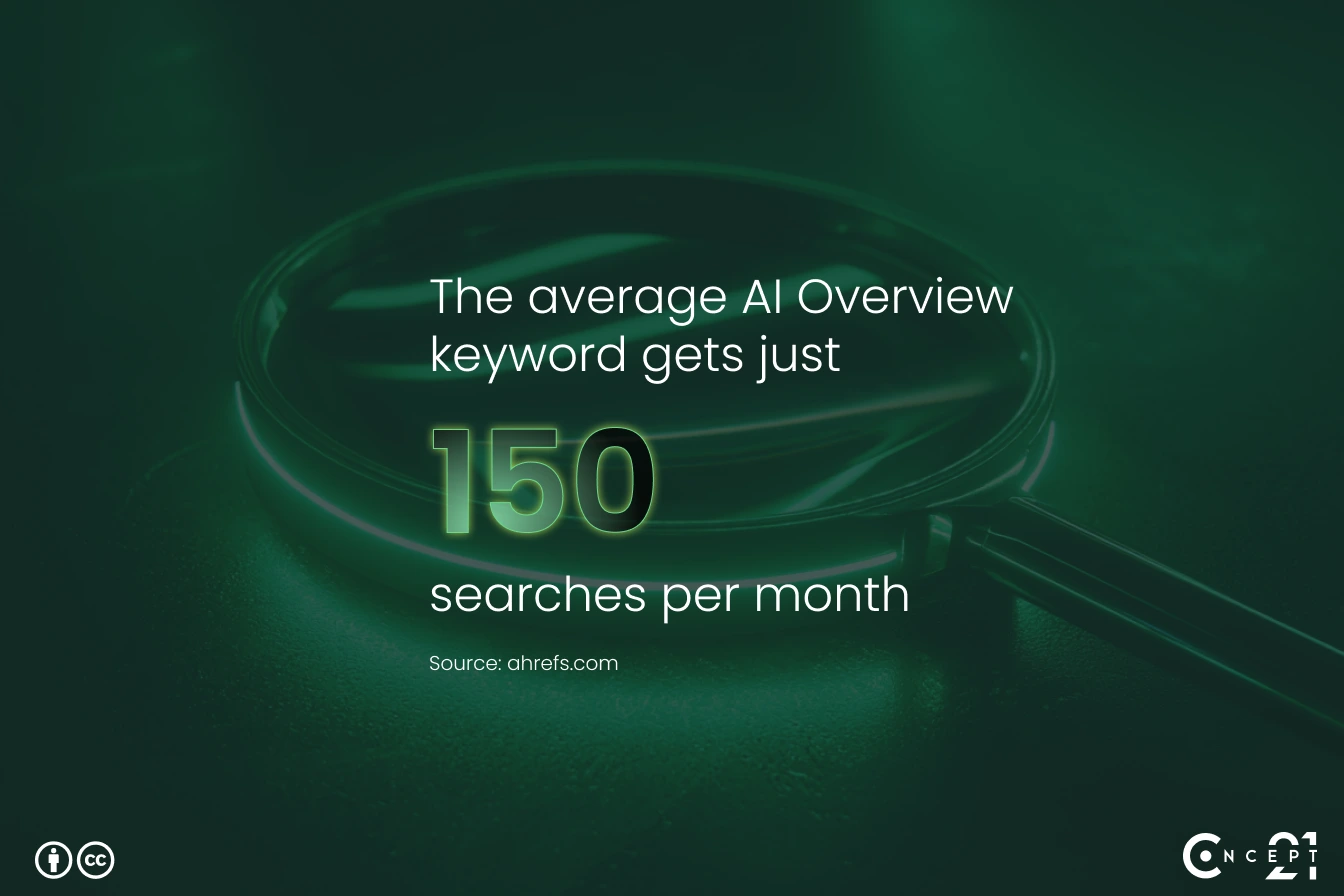
Most responses fall in the 6-to-14-link range.
- The average AI Overview keyword gets just 150 searches per month—193 times smaller than non-AIO keywords, which average 29,000 searches.
- AI Overview queries generate 8 times lower overall traffic potential, but clicks are highly centered within the panel itself.
- Median KD for AIO keywords is 12, compared to 33 for regular keywords.
- 71% of AIO keywords fall below a KD of 30.
- AIO SERPs show 96% fewer sitelinks, 84% fewer videos, 75% fewer knowledge panels.
- For informational queries, AI Overviews pull traffic away from the top 2 organic positions but actually increase traffic for pages ranking between positions 3 and 10.
- For transactional queries, pages included in AI Overviews see increased traffic regardless of their exact ranking on page one.
- AI Overviews have only a 10% chance of appearing for commercial or transactional keywords.
- Nearly 99.2% of AIO-triggering keywords are informational in intent.
What does it mean?
Low search volume doesn’t mean low value. If you own enough of these low-competition niches, the traffic adds up—and with far less rivalry for clicks.
This is your chance to own micro-niches that fly under the radar but deliver steady, highly targeted visitors.
💡Growth Tip:
- Filter for KD < 30 and search volume < 1k in your SEO tool.
- Check the SERP for AI Overview presence paired with few or no ads—this signals a “soft spot” where competition is light.
- Build focused, highly relevant pages or micro-landing pages that answer those specific queries clearly and authoritatively.
Google AI Overview is eating the SERP?
Think of Google’s AI Overview not as a threat, but as an opportunity—a spotlight shining on the most trustworthy, concise, and well-structured answers. Success now belongs to those who adapt quickly, focus on clarity, and build content that earns Google’s trust. The AI Overview rewards precision and authority, and mastering it can revive old content and unlock new growth you didn’t expect.
Ready to take control of your search traffic in the AI era?
Get in touch today for a personalized SEO audit and action plan tailored to the AI-powered future of search. Let’s win the race together.
Ready to take control of your search traffic in the AI era?
Get in touch today for a personalized SEO audit and action plan tailored to the AI-powered future of search. Let’s win the race together.

Not just rankings results that matter
With us, you gain peace of mind, knowing your investment is always protected.
Get Your Customized SEO Plan in 24h!
Karol Andruszkow
Co-founder and CEO of Concept21
Co-founder and CEO of Concept21
Karol is a serial entrepreneur, e-commerce speaker, and founder of 3 startups. He advised hundreds of companies and led projects worth over EUR 50 million for financial institutions across Europe.
He earned two master's degrees – Computer Science and Marketing Management – in Poland and Portugal. He has 10+ years of experience in Silicon Valley, Poland, Portugal, USA, and UK, helping startups, financial institutions, and SMEs improve operations through digitization.
He earned two master's degrees – Computer Science and Marketing Management – in Poland and Portugal. He has 10+ years of experience in Silicon Valley, Poland, Portugal, USA, and UK, helping startups, financial institutions, and SMEs improve operations through digitization.
Karol Andruszkow
Co-founder and CEO of Concept21
Co-founder and CEO of Concept21
Karol is a serial entrepreneur, e-commerce speaker, and founder of 3 startups. He advised hundreds of companies and led projects worth over EUR 50 million for financial institutions across Europe.
He earned two master's degrees – Computer Science and Marketing Management – in Poland and Portugal. He has 10+ years of experience in Silicon Valley, Poland, Portugal, USA, and UK, helping startups, financial institutions, and SMEs improve operations through digitization.
He earned two master's degrees – Computer Science and Marketing Management – in Poland and Portugal. He has 10+ years of experience in Silicon Valley, Poland, Portugal, USA, and UK, helping startups, financial institutions, and SMEs improve operations through digitization.
SHARE: